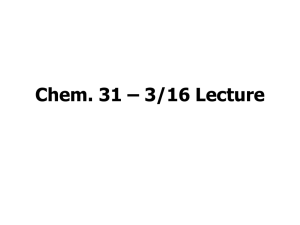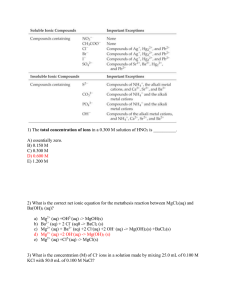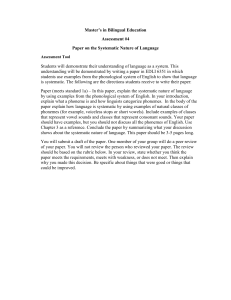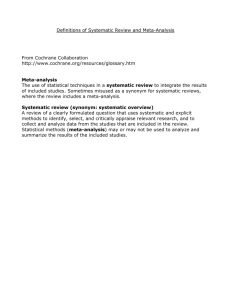Chem. 31 * 9/15 Lecture
advertisement
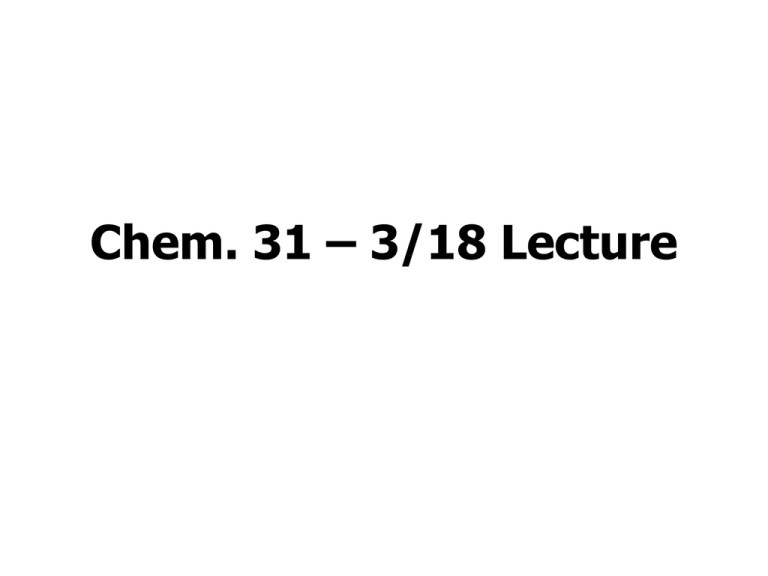
Chem. 31 – 3/18 Lecture Announcements • Water Hardness Lab Report – due today • Today’s Lecture – Chapter 7 “Advanced Equilibrium Theory” - The Systematic Method – – – – Examples of failures 6 steps to method More on Mass Balance General Comments on the Systematic Method The Systematic Method Solubility of MgCO3 – Why did it fail? • • • • • • MgCO3 Mg2+ + CO32x x Equil. (in ICE) 1/2 So x = (Ksp) = 1.87 x 10-4 M (neglecting ionic strength effects) Problem is both ions can react further: enhancements: (% over rxn 1 only) CO32- + H2O HCO3- + OH90% And HCO3- + H2O H2CO3 + OH0% Also, Mg2+ + OH- MgOH+ 9% And Mg2+ + CO32- MgCO3 (aq) 16% Finally, we also have H2O H+ + OH- re-establishing equilibrium Each additional reaction results in greater dissolution To properly solve problem we must consider 6 reactions not just 1 Measured “[CO32-]” from titration = [CO32-] + 0.5[OH-] + 0.5[HCO3-] + [MgCO3] + 0.5[MgOH+] • The “further” reactions makes [Mg2+] ≠ [CO32-], so ICE method fails (or needs modification by ICE tables for other reactions) • Actual solubility is greater than ICE method finds [Mg2+]total = solubility ~ 3.3 x 10-4 M (from systematic approach) Predicted HCl needed = 3.3 mL (close to that measured) These calculations didn’t include activity which would lead to a ~10% increase in solubility (~3.6 mL HCl needed). In 0.1 M NaCl, I get 6.1 mL HCl needed The Systematic Method The Six Steps 1. 2. 3. 4. 5. Write out all relevant reactions Write a “Charge Balance Equation” Write “Mass Balance Equations” Write out all equilibrium equations Check that the number of equations (in 2 to 4 above) = (or maybe >) the number of unknowns (undefined concentrations) 6. Solve for the desired unknown(s) by reducing the equations to one equation with one unknown. Then solve for remaining unknowns Note: the emphasis of teaching the systematic method is steps 1 to 5. Step 6 will be reserved for “easy” problems with 2 to max 3 unknowns The Systematic Method pH of 5.0 x 10-8 M HCl • Demonstrate Method on Board The Systematic Method Conceptual Approach to Mass Balance Equations • With every source of related species, there should be one mass balance equation (or one set for ionic compounds) • Example: – Solubility of AgCl in water with 0.010 M 1,10-phenathroline (Ph) – Reactions: 1) AgCl(s) Ag+ + Cl2) Ag+ + 2Ph Ag(Ph)2+ – Mass Balance equations: • if only rxn 1) [Cl-] = [Ag+] • w/ rxn 2) [Cl-] = [Ag+] + [Ag(Ph)2+] 1,10-phenathroline N N Ag+ Ph Ph Ph Ph Ag+ + Ag Cl + Cl- Ag Cl- Ag+ Cl- 2nd Mass Balance Equation: AgCl(s) +] + [Ph]oNotes: = 0.010 M = [Ph] = [Ph] + 2[Ag(Ph) with rxn 1) Total only, 2 Ag s = 2 Cl s; 2with rxn 2) also, 3 Cls = 22 Phs Ags++one 1 Ag(Ph) Initially 4 Phs, then complex 2 containing 2 Phs (so total # of Phs remains constant) The Systematic Method 2nd Example • An aqueous mixture of CdCl2 and NaSCN is made – Initial concentrations are [CdCl2] = 0.0080 M and [NaSCN] = 0.0040 M – Cd2+ reacts with SCN- to form CdSCN+ K = 95 – HSCN is a strong acid – Ignore any other reactions (e.g. formation of CdOH+) – Ignore activity considerations – Determine the concentrations of all species The Systematic Method 3rd Example • A student prepares a solution that contains 0.050 mol of AgNO3 and 0.0040 mol NH3 in water with a total volume of 1.00 L. The AgNO3 is totally soluble, NH3 is a weak base, and Ag+ reacts with NH3 to form Ag(NH3)2+. Assume the Ag+ does not react with water or OH-. Go through the first 5 steps of the systematic method. The Systematic Method Stong Acid/Strong Base Problems • When do we need to use the systematic approach? – when more than 1 coupled reaction occur (unless coupling is insignificant) – examples: 4.0 x 10-3 M HCl. 7.2 x 10-3 M NaOH – Key point is the charge balance equation: - for strong acid HX, [H+] = [X-] + [OH-] - If [X-] >> [OH-], then [H+] = [X-] – for strong base NaOH, [H+] + [Na+] = [OH-] The Systematic Method General Comments • Effects of secondary reactions – e.g. MgCO3 dissolution – Additional reactions increase solubility – Secondary reactions also can affect pH (CO32+ H2O will produce OH- while Mg2+ + H2O will produce H+) • Software is also available to solve these types of problems (but still need to know steps 1 → 5 to get problems solved)
